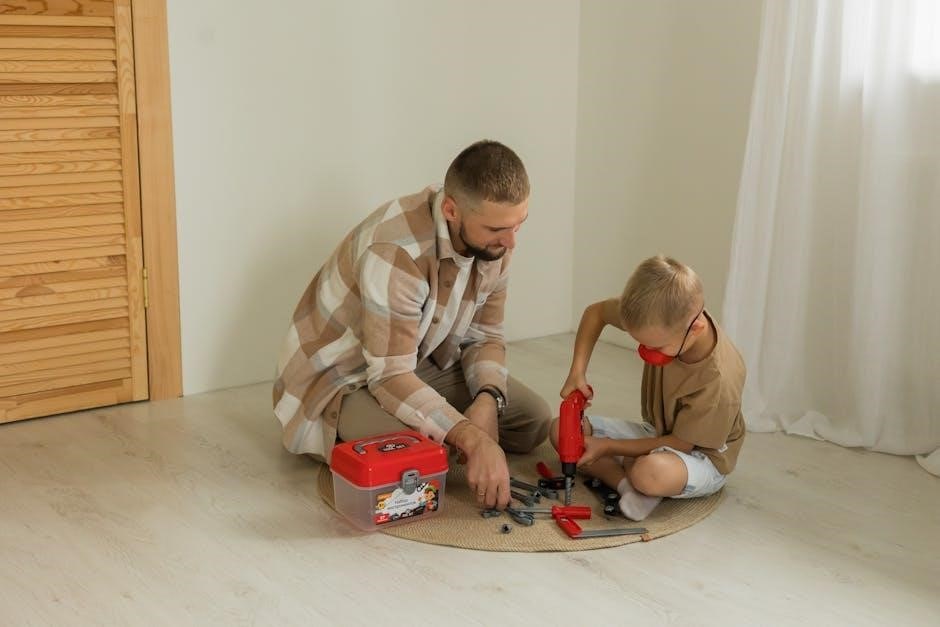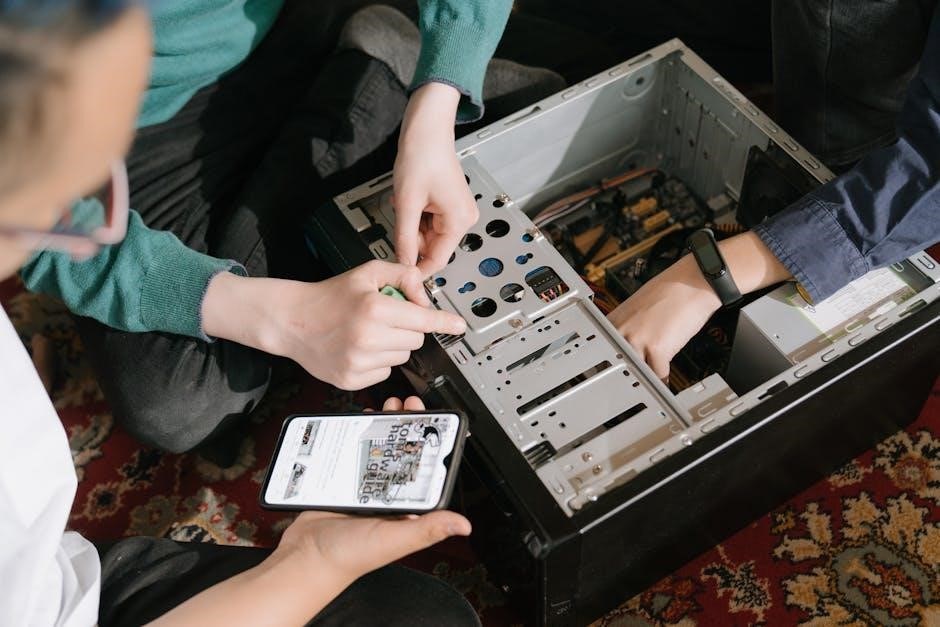This guide provides essential tips for diagnosing and resolving common Toro TimeCutter issues, ensuring optimal performance and longevity. Covers engine, transmission, and cutting problems effectively.
1.1 Importance of Regular Maintenance
Regular maintenance is crucial for extending the lifespan and performance of your Toro TimeCutter. Issues like uneven cutting or engine stalling often stem from neglected upkeep. By adhering to a routine schedule, including oil changes, air filter cleaning, and blade sharpening, you can prevent costly repairs. Proper fluid levels, sharp blades, and clean systems ensure smooth operation. Ignoring maintenance may lead to premature wear and reduce efficiency. Stay proactive to keep your mower running at peak performance and avoid unexpected breakdowns during critical mowing tasks.
1.2 Tools and Equipment Needed
Effective Toro TimeCutter troubleshooting requires the right tools. Essential items include a socket set, pliers, screwdrivers, and wrenches for basic repairs. Safety glasses and gloves protect during maintenance. A multimeter helps diagnose electrical issues, while a pressure gauge checks hydraulic systems. Oil, hydraulic fluid, and a torque wrench are vital for engine and fluid maintenance. A clean air filter and blade sharpening tools ensure optimal cutting performance. Keep a repair manual handy for specific instructions. Having these tools ready saves time and ensures proper fixes for common problems, helping you maintain your mower efficiently.
1.3 Safety Precautions
When troubleshooting your Toro TimeCutter, always prioritize safety. Disconnect the battery or spark plug to prevent accidental start-ups. Wear protective gear like gloves and safety glasses. Ensure the mower is on a level surface and engage the parking brake. Avoid loose clothing that could get caught in moving parts. Be cautious of hot engine components and sharp blades. Never attempt repairs while the mower is operational. Refer to the owner’s manual for specific safety guidelines. Taking these precautions ensures a safe and effective troubleshooting process, protecting both you and your equipment from potential harm.

Common Toro TimeCutter Issues
Toro TimeCutter mowers often face issues like engine problems, hydrostatic transmission faults, uneven cutting, and steering difficulties. These common problems can be resolved with proper troubleshooting techniques.
2.1 Engine Problems
Engine problems are among the most frequent issues in Toro TimeCutter mowers. Common symptoms include difficulty starting, rough idling, or a loss of power during operation. These issues often stem from fuel system restrictions, such as clogged fuel lines or stale fuel, which prevent the engine from receiving the necessary airflow and combustion resources. Faulty spark plugs or dirty air filters can also contribute to poor engine performance. Regular maintenance, such as cleaning or replacing the air filter and ensuring proper fuel flow, can resolve many of these issues. Addressing these problems early is crucial to avoid more severe engine damage and ensure reliable operation.
2.2 Hydrostatic Transmission Issues
Hydrostatic transmission issues are a common problem in Toro TimeCutter mowers, often causing difficulty in moving or maintaining speed. Symptoms include slow acceleration, loss of power, or complete failure to move. These problems can arise from low hydraulic fluid levels, blockages, or worn-out components like drive belts or control arms. Regular checks of hydraulic fluid levels, ensuring proper lubrication, and inspecting for leaks or obstructions can help identify and resolve these issues early. Addressing these problems promptly prevents further damage and ensures smooth operation of the mower. Proper maintenance is key to avoiding costly repairs.
2.3 Cutting Performance
Cutting performance issues in Toro TimeCutter mowers often manifest as uneven cuts, blade stalling, or reduced efficiency. These problems can stem from dull or damaged blades, improper deck adjustment, or clogged cutting decks. Regular blade sharpening or replacement is essential to maintain cutting quality. Additionally, ensuring the deck belt is properly tensioned and free from wear prevents slippage. Cleaning debris from the deck and checking for blockages can also restore optimal performance. Addressing these issues promptly ensures a clean, even cut and extends the mower’s lifespan. Proper maintenance is key to avoiding poor cutting results.
2.4 Steering Problems
Steering issues in Toro TimeCutter mowers can arise from hydraulic system malfunctions or mechanical component wear. Low hydraulic fluid levels or fluid leaks are common causes, leading to reduced steering responsiveness. Additionally, obstructions in the control arm or worn pivot points can hinder smooth operation. Regular lubrication of steering components and ensuring proper fluid levels can prevent these problems. Addressing these issues early helps maintain precise control and overall mowing efficiency, ensuring a seamless cutting experience. Proper maintenance is key to avoiding steering-related frustrations.

Engine-Related Troubleshooting
This section covers common engine issues in Toro TimeCutter mowers, including fuel system problems, spark plug malfunctions, and air filter maintenance, to help restore optimal performance quickly.
3.1 Fuel System Issues
Fuel system problems are a common cause of engine trouble in Toro TimeCutter mowers. Issues often stem from old or contaminated fuel, clogged fuel lines, or faulty fuel filters. Regularly draining old fuel and replacing filters can prevent these problems. If the mower won’t start or runs unevenly, inspect the fuel tank for blockages and ensure the fuel cap is venting properly. Cleaning or replacing clogged components can restore proper fuel flow and engine performance. Always use fresh, high-quality fuel to avoid ethanol-related issues, which can damage the system over time. Proper maintenance ensures reliable operation and extends the mower’s lifespan.
3.2 Spark Plug Problems
A faulty spark plug is a common issue in Toro TimeCutter mowers, leading to difficult starting, rough idling, or poor engine performance. Over time, spark plugs can become fouled by carbon deposits or worn out, disrupting the ignition process. To diagnose, remove the spark plug and inspect for fouling or wear. Clean or replace it as needed, ensuring the gap is set correctly. Using the wrong type of spark plug can also cause problems, so always refer to the manufacturer’s recommendations. Regular spark plug maintenance is crucial for reliable engine operation and overall mower efficiency. Addressing this issue early prevents more severe engine damage.
3.3 Air Filter Maintenance
Regular air filter maintenance is vital for your Toro TimeCutter mower’s performance. A dirty or clogged air filter restricts airflow, reducing engine power and efficiency. Inspect and clean the air filter frequently, especially after mowing dusty areas. If the filter is damaged or excessively dirty, replace it with a genuine Toro part. Proper airflow ensures optimal engine function, prevents overheating, and maintains fuel efficiency. Neglecting air filter maintenance can lead to poor performance and increased wear on engine components. Always follow the manufacturer’s guidelines for cleaning or replacing the air filter to keep your mower running smoothly. Regular maintenance extends the life of your Toro TimeCutter.

Hydrostatic Transmission Troubleshooting
This section covers diagnosing and resolving issues with the hydrostatic transmission, including fluid levels, drive belts, and control arms to ensure smooth operation.
4.1 Hydraulic Fluid Levels
Hydraulic fluid is essential for the smooth operation of your Toro TimeCutter’s transmission. Low fluid levels can cause poor performance or complete system failure. Regularly check the hydraulic fluid level using the dipstick located near the reservoir. If levels are low, refill with the recommended type of hydraulic fluid to avoid contamination. Inspect for leaks around the pump, hoses, and connections, as these can lead to fluid loss. Ensure the control arm moves freely without obstruction, as restricted movement can disrupt fluid flow. Proper fluid maintenance ensures optimal performance and extends the life of your mower’s hydrostatic transmission system.
4.2 Drive Belt Replacement
The drive belt plays a crucial role in powering the Toro TimeCutter’s wheels and cutting deck. Over time, the belt may crack, slip, or break, causing the mower to lose mobility or functionality. Inspect the belt for visible wear, fraying, or misalignment. If damaged, replace it with a genuine Toro part to ensure compatibility and durability. Proper installation involves aligning the belt correctly on the pulleys and tensioning it as specified in the manual. Regular checks and timely replacements prevent unexpected breakdowns and maintain your mower’s performance. Always refer to the owner’s manual for detailed replacement instructions and safety precautions.
4.3 Control Arm Adjustment
Proper adjustment of the control arm is essential for smooth operation of the Toro TimeCutter’s hydrostatic transmission. If the control arm is misaligned or obstructed, it can lead to inconsistent speed, difficulty in steering, or complete loss of movement. To address this, ensure the control arm moves freely and is not restricted by debris or tight connections. Lubricate pivot points regularly to maintain smooth operation. Adjust the control arm according to the manufacturer’s specifications to restore proper functionality. Regular checks and adjustments prevent long-term damage and ensure optimal performance of the mower’s hydrostatic system. Always consult the owner’s manual for specific adjustment procedures.

Cutting Performance Troubleshooting
Addressing cutting performance issues ensures a clean, even lawn finish. Common problems include uneven cutting, dull blades, and misaligned deck belts. Regular blade sharpening and deck adjustments can resolve these issues effectively, restoring optimal mowing efficiency.
5.1 Uneven Cutting
Uneven cutting is a common issue with the Toro TimeCutter, often caused by dull or damaged blades, misaligned cutting decks, or uneven tire pressure. To resolve this, inspect and sharpen or replace blades, adjust the deck height to ensure even alignment, and check tire pressure for consistency. Proper blade maintenance and deck adjustments can significantly improve cutting performance, ensuring a uniform lawn appearance. Regular servicing and inspections help prevent such issues, keeping your mower operating at its best. Addressing these factors promptly will restore your mower’s ability to deliver a clean, professional-grade cut.
5.2 Blade Maintenance
Proper blade maintenance is crucial for optimal cutting performance. Dull or damaged blades can lead to uneven cuts and tear grass, leaving it vulnerable to disease. Regularly inspect blades for sharpness, wear, or damage, and sharpen or replace them as needed. Sharpen blades when they become dull, typically every 25 hours of use. Bent or damaged blades should be replaced immediately to avoid vibration and further damage. Additionally, ensure blades are balanced to maintain even cutting and smooth mower operation. Proper blade care not only enhances cutting quality but also extends the lifespan of your Toro TimeCutter mower.
5.3 Deck Belt Adjustment
Deck belt adjustment is essential for maintaining proper cutting performance. Over time, the deck belt may become misaligned or worn, leading to uneven cutting or complete stoppage. Inspect the belt regularly for signs of wear, cracks, or fraying. If damaged, replace the belt immediately. Adjust the belt tension by loosening the deck pulley nuts and sliding the belt into the correct position. Ensure the belt is properly seated on all pulleys and tighten the nuts securely. Misaligned or loose belts can cause poor cutting quality and increased strain on the mower. Regular adjustment ensures smooth operation and prevents premature wear on other components.

Steering System Troubleshooting
Steering issues in Toro TimeCutter mowers often arise from hydraulic fluid level imbalances or mechanical component wear. Check fluid levels and refill if necessary. Inspect for leaks and ensure all connections are secure. Worn or damaged steering components, such as pivot pins or control arms, may require replacement. Additionally, electrical faults in sensors or wiring can disrupt steering functionality. Regular lubrication of moving parts and alignment checks can prevent many problems. Addressing these issues promptly ensures smooth operation and maintains the mower’s maneuverability.
6.1 Hydraulic Fluid Levels
Low hydraulic fluid levels are a common cause of steering issues in Toro TimeCutter mowers. Always check the fluid level using the dipstick or sight gauge. If levels are low, refill with the recommended hydraulic fluid type. Overfilling can damage the system, so adhere to the manufacturer’s guidelines. Inspect for leaks around hoses, pumps, and connections. Regular fluid checks prevent system failure and ensure smooth steering operation. Maintaining proper hydraulic fluid levels is crucial for optimal performance and longevity of the steering system. Addressing fluid-related issues early avoids costly repairs and downtime. Ensure the mower is on level ground during checks for accuracy.
6.2 Mechanical Components
Mechanical components play a crucial role in the steering system of your Toro TimeCutter. Regular inspection of parts like control arms, bushings, and pivot points is essential to identify wear or damage. Lubricate moving parts to prevent friction and ensure smooth operation. Misaligned or loose components can disrupt steering accuracy. Addressing these issues promptly avoids further damage. Replace worn or damaged parts with genuine Toro replacements to maintain performance. Neglecting mechanical upkeep can lead to costly repairs and reduced mower efficiency. Always refer to your owner’s manual for specific maintenance recommendations and procedures. Proper care extends the lifespan of your mower’s steering system.
6.3 Electrical Issues
Electrical problems can disrupt the steering and overall operation of your Toro TimeCutter. Common issues include faulty sensors, corroded connections, or damaged wiring. Check the ignition switch and battery for proper function. Loose or corroded terminals can prevent electrical signals from being transmitted. Inspect the wiring harness for signs of wear or damage. Addressing these issues promptly ensures reliable performance. Use a multimeter to test electrical components and replace any faulty parts. Regular maintenance of the electrical system prevents unexpected breakdowns and keeps your mower running smoothly. Always follow safety guidelines when working with electrical components. Proper diagnostics and repairs are essential for optimal functionality.

Electrical System Troubleshooting
Identify and resolve electrical issues by checking sensors, connections, and wiring. Faulty components like the ignition switch or battery can cause startup problems. Use a multimeter to test electrical systems for proper function and safety.
7.1 Ignition Switch
The ignition switch is a critical component of the electrical system. If your Toro TimeCutter fails to start, the ignition switch may be faulty. Test it using a multimeter to ensure proper electrical continuity. Worn or corroded contacts can prevent the mower from starting. Check for loose connections or damaged wires connected to the switch. If the switch is defective, replace it with a genuine Toro part. Regular maintenance, such as cleaning the switch and connections, can prevent issues. If the problem persists, consult a professional for further assistance. Proper functioning ensures reliable engine performance and safety.
7.2 Battery Issues
Battery problems are a common cause of starting issues in Toro TimeCutter mowers. Check for corrosion on terminals and cables, as this can prevent proper electrical flow. Test the battery voltage using a multimeter; it should read around 12.6 volts when fully charged. If the battery is dead, charge it according to the manufacturer’s instructions. Loose connections or damaged cables can also cause malfunction. Replace the battery if it’s old or no longer holds a charge. Ensure the ignition switch is functioning correctly, as it directly affects battery performance. Regular maintenance can prevent these issues and ensure reliable starting.
7.3 Sensor Malfunctions
Sensor malfunctions can disrupt the operation of your Toro TimeCutter. The seat switch sensor, for instance, may prevent the mower from starting if it detects an invalid seat position. Check connections and ensure the sensor is clean and free from debris. Additionally, blade engagement sensors can fail, causing the cutting deck to malfunction. Use a multimeter to test sensor continuity and voltage. If a sensor is faulty, replace it with an OEM part. Regularly inspect and clean sensors to prevent false readings. Addressing these issues promptly ensures smooth operation and avoids unnecessary downtime.

Wheel and Tire-Related Issues
Common issues include uneven tire wear, low tire pressure, and mechanical misalignment. Check pressure regularly, inspect for punctures, and ensure proper wheel alignment and torque specifications.
8.1 Tire Pressure
Proper tire pressure is crucial for optimal performance and traction. Under-inflated tires can lead to uneven wear and reduced control. Always check pressure before use, adhering to manufacturer guidelines. Use a reliable gauge to ensure accuracy. Seasonal temperature changes can affect pressure levels, so adjust accordingly. Maintaining correct tire pressure enhances stability, especially on slopes, and prevents premature tire damage. Refer to your Toro TimeCutter’s manual for specific recommendations to ensure safety and efficiency while operating the mower.
8.2 Wheel Alignment
Proper wheel alignment is essential for stable handling and even cutting performance. Misaligned wheels can cause uneven tire wear and reduced traction. Check alignment if you notice vibration while mowing or uneven cutting patterns. Inspect the caster and camber adjustments, ensuring they match the manufacturer’s specifications. Adjustments should be made carefully to avoid further issues. If unsure, consult a professional to ensure accurate alignment. Proper alignment enhances maneuverability and extends the life of your Toro TimeCutter’s tires, ensuring smooth operation and consistent results.
8.3 Tire Wear
Uneven or excessive tire wear on your Toro TimeCutter can indicate underlying issues. Check tires regularly for signs of wear, such as uneven tread or bald spots. Misaligned wheels or improper tire pressure often cause uneven wear. Inspect for punctures or debris, which can lead to premature wear. Rotate tires periodically to ensure even wear. Addressing tire wear promptly prevents further damage and maintains optimal mower performance. Refer to your owner’s manual for recommended tire pressure and maintenance tips to extend the life of your tires and ensure consistent mowing results.

Battery and Charging System
Ensure your Toro TimeCutter’s battery is functioning properly by checking connections and testing voltage. A weak or dead battery can prevent startup; recharge or replace as needed.
9.1 Battery Testing
Testing the battery is crucial to ensure your Toro TimeCutter operates smoothly. Start by checking the battery terminals for cleanliness and tightness. Use a multimeter to measure voltage, which should read around 12.6V for a fully charged battery. If the voltage is low, charge the battery according to the manufacturer’s instructions. A load test can also determine if the battery holds power under normal operating conditions. If the battery fails these tests, it may be time to replace it. Regular testing helps prevent unexpected startups and ensures reliable performance during mowing sessions.
9.2 Charging Procedures
Proper charging is essential for maintaining your Toro TimeCutter’s battery health. Always use the charger recommended by Toro to avoid damage; Ensure the battery is switched off before charging. Connect the charger to the battery terminals, making sure the polarity is correct. Charge the battery in a well-ventilated area, away from flammable materials. Avoid overcharging, as it can shorten the battery’s lifespan. Once fully charged, unplug the charger and store the battery in a cool, dry place. Regular charging maintenance helps prevent startup issues and ensures reliable performance during mowing sessions.

When to Seek Professional Help
Consult a professional if issues persist after basic troubleshooting. Major repairs, complex electrical faults, or hydraulic system damages require expert attention to ensure safety and proper resolution.
10.1 Major Repair Needs
Major repairs, such as replacing the transmission or engine, require professional expertise. These tasks involve complex tools and extensive knowledge. Attempting them without proper skills can lead to further damage, safety risks, or voided warranties. Additionally, issues like hydraulic system overhauls or electrical component replacements are best handled by certified technicians. They have the necessary experience and access to genuine parts to ensure the job is done correctly and efficiently. Always consult the Toro service manual or contact authorized dealers for such critical repairs to maintain your mower’s performance and longevity.
10.2 Warranty and Support
Toro offers comprehensive warranty coverage for TimeCutter mowers, ensuring protection against defects in materials and workmanship. The warranty period varies by model and component, typically covering the engine, transmission, and other critical parts for several years. For valid claims, contact authorized Toro dealers, who provide genuine parts and expert service. Additionally, Toro offers dedicated customer support through their website, including troubleshooting guides, manuals, and FAQs. This robust support system helps users maintain their mowers’ performance and quickly resolve issues, ensuring years of reliable service and satisfaction.
Toro TimeCutter troubleshooting empowers owners to resolve common issues efficiently, saving time and money. By addressing problems early and performing regular maintenance, users can ensure their mower runs smoothly for years. Whether it’s engine issues, transmission problems, or cutting performance, this guide provides clear solutions. Toro’s robust warranty and customer support further enhance the ownership experience. With the right tools and knowledge, you can keep your TimeCutter in peak condition, maintaining your lawn’s appearance effortlessly. Troubleshooting is key to extending the lifespan of your mower and enjoying optimal performance season after season.